Timothy Shea
Neuromorphic Optical Tracking and Imaging of Randomly Moving Targets through Strongly Scattering Media
Jan 07, 2025



Abstract:Tracking and acquiring simultaneous optical images of randomly moving targets obscured by scattering media remains a challenging problem of importance to many applications that require precise object localization and identification. In this work we develop an end-to-end neuromorphic optical engineering and computational approach to demonstrate how to track and image normally invisible objects by combining an event detecting camera with a multistage neuromorphic deep learning strategy. Photons emerging from dense scattering media are detected by the event camera and converted to pixel-wise asynchronized spike trains - a first step in isolating object-specific information from the dominant uninformative background. Spiking data is fed into a deep spiking neural network (SNN) engine where object tracking and image reconstruction are performed by two separate yet interconnected modules running in parallel in discrete time steps over the event duration. Through benchtop experiments we demonstrate tracking and imaging randomly moving objects in dense turbid media as well as image reconstruction of spatially stationary but optically dynamic objects. Standardized character sets serve as representative proxies for geometrically complex objects, underscoring the method's generality. The results highlight the advantages of a fully neuromorphic approach in meeting a major imaging technology with high computational efficiency and low power consumption.
Solving QUBO on the Loihi 2 Neuromorphic Processor
Aug 06, 2024Abstract:In this article, we describe an algorithm for solving Quadratic Unconstrained Binary Optimization problems on the Intel Loihi 2 neuromorphic processor. The solver is based on a hardware-aware fine-grained parallel simulated annealing algorithm developed for Intel's neuromorphic research chip Loihi 2. Preliminary results show that our approach can generate feasible solutions in as little as 1 ms and up to 37x more energy efficient compared to two baseline solvers running on a CPU. These advantages could be especially relevant for size-, weight-, and power-constrained edge computing applications.
Event-Driven Imaging in Turbid Media: A Confluence of Optoelectronics and Neuromorphic Computation
Sep 13, 2023



Abstract:In this paper a new optical-computational method is introduced to unveil images of targets whose visibility is severely obscured by light scattering in dense, turbid media. The targets of interest are taken to be dynamic in that their optical properties are time-varying whether stationary in space or moving. The scheme, to our knowledge the first of its kind, is human vision inspired whereby diffuse photons collected from the turbid medium are first transformed to spike trains by a dynamic vision sensor as in the retina, and image reconstruction is then performed by a neuromorphic computing approach mimicking the brain. We combine benchtop experimental data in both reflection (backscattering) and transmission geometries with support from physics-based simulations to develop a neuromorphic computational model and then apply this for image reconstruction of different MNIST characters and image sets by a dedicated deep spiking neural network algorithm. Image reconstruction is achieved under conditions of turbidity where an original image is unintelligible to the human eye or a digital video camera, yet clearly and quantifiable identifiable when using the new neuromorphic computational approach.
The Intel Neuromorphic DNS Challenge
Mar 17, 2023Abstract:A critical enabler for progress in neuromorphic computing research is the ability to transparently evaluate different neuromorphic solutions on important tasks and to compare them to state-of-the-art conventional solutions. The Intel Neuromorphic Deep Noise Suppression Challenge (Intel N-DNS Challenge), inspired by the Microsoft DNS Challenge, tackles a ubiquitous and commercially relevant task: real-time audio denoising. Audio denoising is likely to reap the benefits of neuromorphic computing due to its low-bandwidth, temporal nature and its relevance for low-power devices. The Intel N-DNS Challenge consists of two tracks: a simulation-based algorithmic track to encourage algorithmic innovation, and a neuromorphic hardware (Loihi 2) track to rigorously evaluate solutions. For both tracks, we specify an evaluation methodology based on energy, latency, and resource consumption in addition to output audio quality. We make the Intel N-DNS Challenge dataset scripts and evaluation code freely accessible, encourage community participation with monetary prizes, and release a neuromorphic baseline solution which shows promising audio quality, high power efficiency, and low resource consumption when compared to Microsoft NsNet2 and a proprietary Intel denoising model used in production. We hope the Intel N-DNS Challenge will hasten innovation in neuromorphic algorithms research, especially in the area of training tools and methods for real-time signal processing. We expect the winners of the challenge will demonstrate that for problems like audio denoising, significant gains in power and resources can be realized on neuromorphic devices available today compared to conventional state-of-the-art solutions.
Gesture Similarity Analysis on Event Data Using a Hybrid Guided Variational Auto Encoder
Mar 31, 2021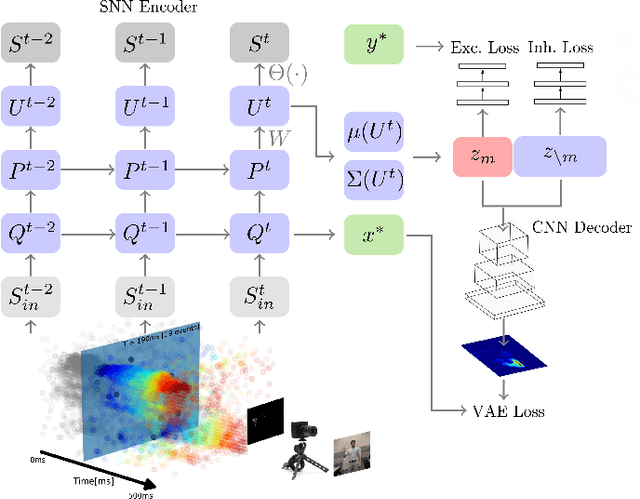
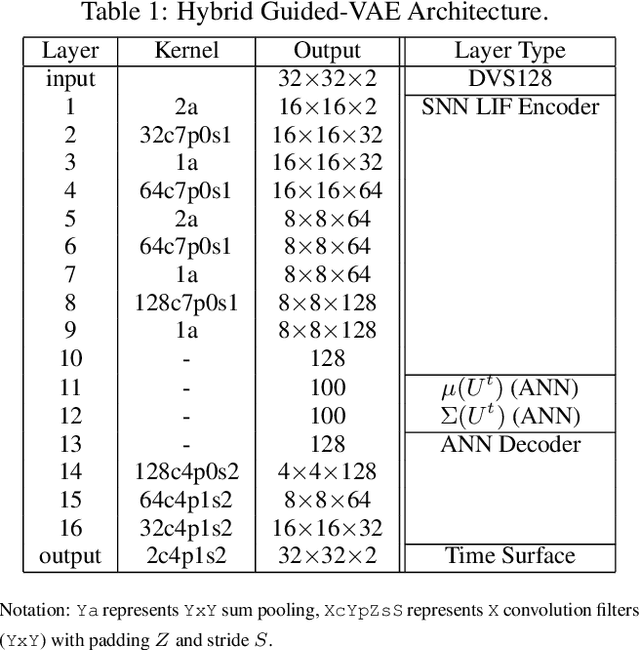

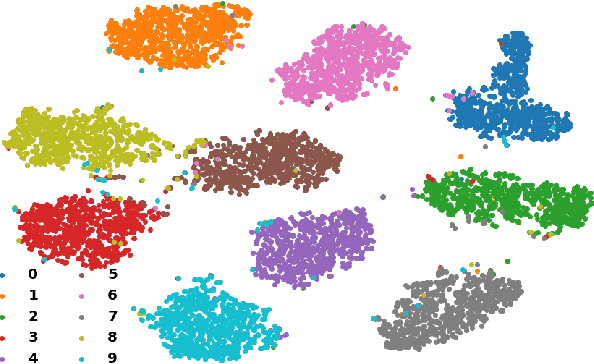
Abstract:While commercial mid-air gesture recognition systems have existed for at least a decade, they have not become a widespread method of interacting with machines. This is primarily due to the fact that these systems require rigid, dramatic gestures to be performed for accurate recognition that can be fatiguing and unnatural. The global pandemic has seen a resurgence of interest in touchless interfaces, so new methods that allow for natural mid-air gestural interactions are even more important. To address the limitations of recognition systems, we propose a neuromorphic gesture analysis system which naturally declutters the background and analyzes gestures at high temporal resolution. Our novel model consists of an event-based guided Variational Autoencoder (VAE) which encodes event-based data sensed by a Dynamic Vision Sensor (DVS) into a latent space representation suitable to analyze and compute the similarity of mid-air gesture data. Our results show that the features learned by the VAE provides a similarity measure capable of clustering and pseudo labeling of new gestures. Furthermore, we argue that the resulting event-based encoder and pseudo-labeling system are suitable for implementation in neuromorphic hardware for online adaptation and learning of natural mid-air gestures.
End-to-End Auditory Object Recognition via Inception Nucleus
May 25, 2020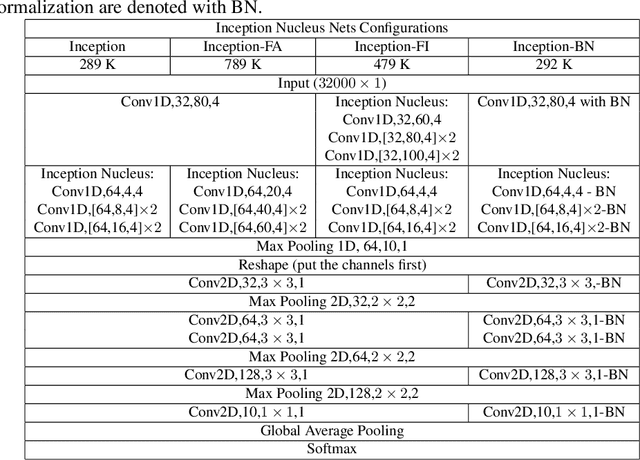
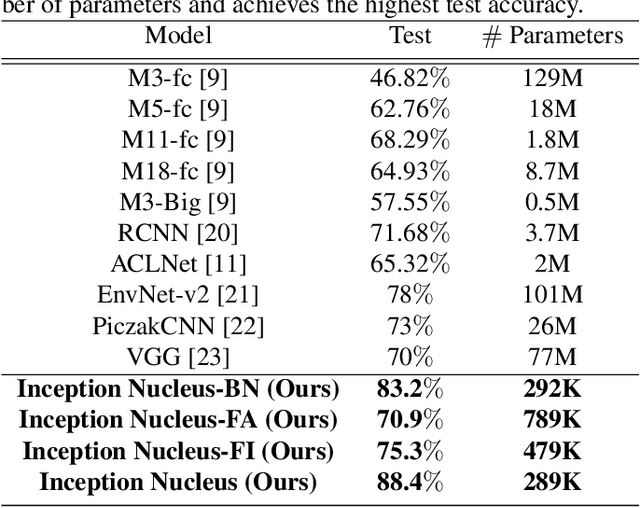

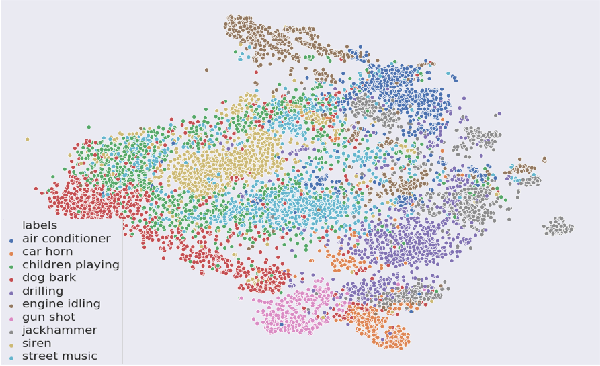
Abstract:Machine learning approaches to auditory object recognition are traditionally based on engineered features such as those derived from the spectrum or cepstrum. More recently, end-to-end classification systems in image and auditory recognition systems have been developed to learn features jointly with classification and result in improved classification accuracy. In this paper, we propose a novel end-to-end deep neural network to map the raw waveform inputs to sound class labels. Our network includes an "inception nucleus" that optimizes the size of convolutional filters on the fly that results in reducing engineering efforts dramatically. Classification results compared favorably against current state-of-the-art approaches, besting them by 10.4 percentage points on the Urbansound8k dataset. Analyses of learned representations revealed that filters in the earlier hidden layers learned wavelet-like transforms to extract features that were informative for classification.
 Add to Chrome
Add to Chrome Add to Firefox
Add to Firefox Add to Edge
Add to Edge